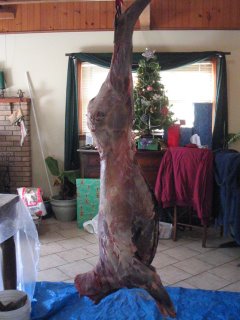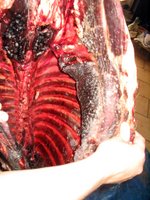 If you're a vegetarian, or you otherwise think deer are so cute and cuddly that nothing bad should ever happen to them, click away to another site right now. This is going to be a fairly gruesome combination of pictures and descriptions.
If you're a vegetarian, or you otherwise think deer are so cute and cuddly that nothing bad should ever happen to them, click away to another site right now. This is going to be a fairly gruesome combination of pictures and descriptions.I'm not a vegetarian. I also think that people who are going to eat meat should be willing to get their hands dirty. Too many people think meat comes from the grocery store. My grandfather took me hunting a couple of times when I was younger. I didn't kill anything on those trips, but I did pull the trigger with intent to kill a couple of times, so I'm comfortable with my place at the top of the food chain. I also helped clean and cut up the kills that other hunters made; I got over my squeamishness pretty quickly. I prefer to let others do the dirty work these days, but I will get in there when the need arises. I must admit that my good lady wife did most of the work on this occasion, but I did lend a hand as needed.
So, my father-in-law shot a deer for us a few weeks ago. It spent some time in the freezer, then a few days hanging in the cool wintery air, and today it came into the house to be dismembered. The loft design of our house, with exposed rafters, makes this process much easier, but lugging around over a hundred pounds of dead weight (yeah, pun intended) is still no easy task. Still, we managed to get the deer from its hanging place in the barn to a new hanging place in the house without too much trouble.
 The hanging, by the way, reported takes away some of the "gamey" taste that turns some people off venison and tenderizes the meat by stretching out the tissue. The "aging" process needs to occur in temperatures of around 40 degrees Fahrenheit and low humidity. It will take three to ten days, depending on temperatures. This is a bit creepy, but if you find a bit of mold growing inside the rib cage, that's actually a good sign. Where you have mold, you don't have nasty bacteria. Basically, if it's gotten slimy and stinky, it may no longer be safe. I suppose you could wash any visible mold from parts you plan to eat, but we're actually making jerky treats for our dogs from those.
The hanging, by the way, reported takes away some of the "gamey" taste that turns some people off venison and tenderizes the meat by stretching out the tissue. The "aging" process needs to occur in temperatures of around 40 degrees Fahrenheit and low humidity. It will take three to ten days, depending on temperatures. This is a bit creepy, but if you find a bit of mold growing inside the rib cage, that's actually a good sign. Where you have mold, you don't have nasty bacteria. Basically, if it's gotten slimy and stinky, it may no longer be safe. I suppose you could wash any visible mold from parts you plan to eat, but we're actually making jerky treats for our dogs from those.I didn't think to immortalize the earliest stages of the process in pictures, so you don't have to witness the beheading and skinning of the beast. Basically, the decapitation involves cutting a ring around the neck all the way to the spine, then popping the vertebrae apart. Skinning requires cutting the skin away starting at the legs (from which the deer is suspended) and then pulling with all your weight while using a skinning knife to help the skin separate from the underlying muscle.
With the hide off, the true dismemberment began. This basically involves separating large tracts of muscle from the bone, starting with my lady's favorite cut: the backstrap. Once the assorted cuts are removed, they get washed (my job!) and refrigerated until they can be further cut down into individual servings.
The hide went into a plastic bag and then into the freezer, hopefully to eventually go into someone's leatherworking project. Assorted bones and other unpalatable bits of the animal went to a compost pile, except for a few bones that went to some extremely happy dogs.
If you're one of my local readers, and you want a deer hide for tanning, let me know.

No comments:
Post a Comment